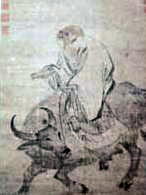Lao Tse
Lao Tse, an older contemporary of Confucius, was keeper of the imerpial archives at Loyang in the Honan province during the sixth century BCE. [1] He is regarded by historians as the author of the Tao Te Ching or The Classic of The Way and Its Virtue. The aphorisms found in the Tao Te Ching are considered to be at the core of the Taoist canon, and, by reflection, Lao Tse is generally considered to be, if not the father of Taoism, then at least the first identifiable codifier of Taoist thought. Spellings of the name Lao Tse vary, and include; Lao Tsu, Lao-Tzu. Lao Zi, and Laozi.
The name Lao Tse itself is an honorific. Lao is translated as "venerable" or "old", and Tse can be translated literally as "child" or "offspring", but it was also a term for a rank of nobleman equivalent to viscount [2] [3], as well as a term of respect attached to the names of revered scholars. Thus, "Lao Tse" can be translated as "the old master”, or perhaps more elegantly, “the old boy.”
Lao Tse is believed by some to have been a teacher of Confucius. A popular account of their meeting is reflected in the quote[4][5] often translated more or less:
"I know that birds can fly and fish can swim and beasts can run. But dragons! I shall never know how they ride wind and cloud up into the sky. Today I saw Lao Tzu. What a dragon!"
But Lao Tse's existence is disputed by historians. Stanford's online Philosophy Encyclopedia[6] states the Tao Te Ching is a composite text "written and rewritten over centuries with varied input from multiple anonymous writers"[7], whereas Merriam-Webster's Lao Tse entry[8] (although they use the Lao-Tzu spelling) states as a fact that he was a "6th century b.c. Chinese philosopher" originally (named) Li Erh.
Sadly, the exact details surrounding Lao Tse and the creation of the Tao Te Ching have been lost to the centuries, but most popular versions[9][10][11][12] of the legend go something like this:
Lao Tse was the keeper of the archives (what we might today think of as 'the wise man') in one of the many kingdoms that are now part of China. When he saw that the kingdom was in decline, he decided to leave. Upon reaching the border, the official in charge of the border pass stopped him and asked him to put his teachings into writing. And so before leaving, Lao Tse wrote out the 5000 words of the Tao Te Ching for posterity.
Many versions of the story as well as at least one famous depiction have Lao Tse riding an ox out into the wilderness.
References:
- ↑ English, J., Feng, Gia-Fu. (1972). Tao Te Ching. Vintage Books: New York.
- ↑ http://www.chinaknowledge.de/History/titles.html
- ↑ http://www.biographybase.com/biography/Lao_Tzu.html
- ↑ http://borges.uiowa.edu/vakalo/zf/html/body_the_chinese_dragon.html
- ↑ http://www.terebess.hu/english/tao/bynner.html
- ↑ http://plato.stanford.edu/
- ↑ http://plato.stanford.edu/entries/taoism/
- ↑ http://www.merriam-webster.com/dictionary/Lao-tzu
- ↑ http://www.chebucto.ns.ca/Philosophy/Taichi/lao.html
- ↑ http://members.aol.com/MrSage365/LaoTzu.html
- ↑ http://www.metrotimes.com/arts/lq/18/summer/leguin.html
- ↑ http://www.poetseers.org/the_poetseers/lao_tzu
